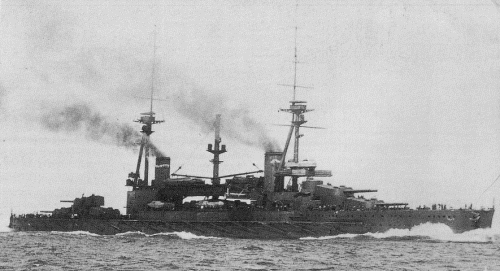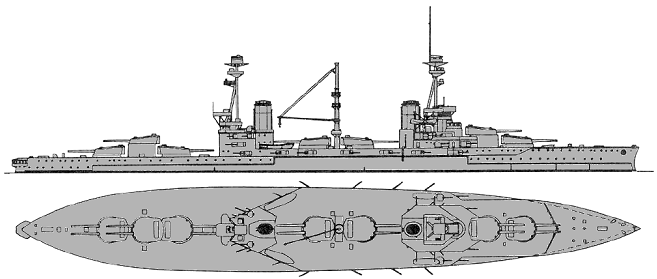
NAVYPEDIA
 Support the project with paypal
Support the project with paypal
Photo

Agincourt 1914
Ships
| Name | No | Yard No | Builder | Laid down | Launched | Comp | Fate |
|---|---|---|---|---|---|---|---|
| Agincourt (ex-Sultan Osman I, ex-Rio de Janeiro) | 53, 04, 09 | 792 | Armstrong, Elswick | 9/1911 | 22.1.1913 | 8/1914 | sold for BU 12.1922 |
Technical data
| Displacement normal, t | 27500 |
|---|---|
| Displacement full, t | 30250 |
| Length, m | 204.7 |
| Breadth, m | 27.1 |
| Draught, m | 8.20 mean |
| No of shafts | 4 |
| Machinery | 4 sets Parsons geared steam turbines, 22 Babcock & Wilcox boilers |
| Power, h. p. | 34000 |
| Max speed, kts | 22 |
| Fuel, t | 3200 coal + 620 oil |
| Endurance, nm(kts) | 4500(10) |
| Armour, mm | belt: 229 - 102, bulkheads: 203 - 102, turrets: 305 (faces), barbettes: 229 - 76, deck: 64 - 25, CT: 305 |
| Armament | 7 x 2 - 305/45 BL Mk XIII, 20 x 1 - 152/50 BL Mk XIII, 10 x 1 - 76/50 23cwt QF Mk I, 2 x 1 - 76/45 20cwt QF Mk I, 3 - 533 TT (2 beam, 1 stern) |
| Complement | 1115 |
Standard scale images

Agincourt 1915
Graphics
Project history
To answer the Argentine battleships Moreno and Rivadavia Brazil wished to have the most powerful ship in the world. Designs armed with 8 406mm and 10 381mm guns were looked at, but finally a 12 356mm guns design had been accepted. At the last moment, however, a change of government led to the ship being cancelled, and in its place was to be built a ship with maximum number of guns. Designers of Armstrong draw up plans for an immensely long ship with 7 turrets on centreline. The design was accepted, and she was laid down as Rio de Janeiro, but in July 1912 Brazilian Government began to look for a buyer for her. Turkey bought her for 2,725,200£ and renamed the ship Sultan Osman I. The ship was complete when war broke out and was being docked at Devonport, but Churchill ordered that she should be delayed until Turkey's position became clear. As soon as Turkey showed that she was friendly to Germany the ship was seized and incorporated into the Royal Navy.
The ship required major alterations before commission. The massive flying deck between the funnels was removed, along with torpedo nets. As with the Erin the scale of protection and endurance was not up to RN standards. In the RN she was not highly regarded, partly because her non-standard equipment put her in dockyard hands frequently but principally because of her light protection and, as Oscar Parkes said, she was regarded as nothing more than a 'floating magazine with a tremendous volume of fire as her best protection'. The turrets were unusual in having all loading operations controlled by a single lever.
Protection
Main 229mm armoured belt had 111.3m lemgth and was extended between barbettes 'B' and 'Y'. It was 4.1m deep, lower edge was in 1.5m below waterline. This pat of main belt was closed by 76mm fwd and aft bulkheads. 15.2m-long part of the belt forward from the centre of barbette 'B' had 152mm thickness and later to the stem the belt had 102mm thickness. Additional 76mm bulkhead was installed between 152mm and 102mm parts of the belt fwd. Aft from the centre of barbette 'Y' at 9.1m length the belt had 152mm thickness and was closed by 152mm(between main and middle decks)-76mm(between the middle and lower decks) bulkhead. Aft from this part the 102mm belt was extended to the 102mm bulkhead in ~3m from the stern, this bulkhead protected the space between middle and lower decks. Upper 152mm belt protected the space between barbettes 'B' and 'X' and upper and main decks and was connected with ''B' and 'Y' barbettes by 152mm bulkheads. Secondary battery was protected by 152mm armour, the guns inside battery were separated from each other by 25mm bulkheads.
Turrets had 305mm faces, 203mm sides and 254mm rears. Turret roofs had 76mm thickness in the fore part of turret and 51mm at the back part. 'A' barbette had 229mm protection above the main deck. Fore part of 'B' barbette had 229mm thickness above the main deck, aft part and sides had 229mm protection above the forecastle deck and 76mm between forecastle and main decks. 'P' and 'Q' barbettes had 229mm protection above the forecastle deck and 76mm between forecastle and main decks. Armour of 'X' barbette was 229mm above the upper deck, 76mm between the upper and main decks and 51mm between the main and middle decks. Aft part of the 'Y' barbette had 229mm thickness above the main deck, fore part and sides had 229mm protection above the upper deck and 76mm between upper and main decks. 'Z' barbette had 229mm protection above the main deck and 76mm(aft part)-51mm(fore part and sides) between middle and main decks.
Forecastle deck above the battery had 38mm thickness. Upper deck between 'Q' and 'X' barbettes, over engine room and aft boiler room, had 38mm armour. Main deck had 38mm thickness between 76mm fwd and 152mm aft bulkheads and 25mm between 76mm fwd bulkhead and the stem. Middle deck between 76mm fwd bulkhead and the stern had 25mm flat and 38mm slopes. Lower deck between the stem and fwd 76mm bulkhead had 25mm protection, between this bulkhead and fwd bulkhead of fwd boiler room it was 38mm, 38-25mm over boiler and engine rooms and 'P' and 'Q' magazines and 64mm between aft engine room and the stern. Magazines were protected by 38-35mm screens between the double bottom and main deck.
CT had 305mm sides, 102mm roof and 76mm floor, communication tube had 152mm armour above the upper deck and 51mm between upper and middle decks. Aft CT had 229mm sides and 76mm floor.
Modernizations
1916: tripod mainmast was removed, topmast was re-stepped on the derrick post amidships
1918: bridgework was enlarged
Naval service
Agincourt was put on Disposal List in 1919 but recommissioned in 1921 for experimental work and then stripped for conversion to 'Mobile Naval Base' or large depot ship. This involved the removal of all but No1 and 2 turrets and the provision of extra oil fuel and ammunition stowage. Work was stopped late in 1921 (a rumoured resale to Brazil did not materialize) and she was sold for BU in 1922.
Many thanks to Wolfgang Stöhr for additional information on this page.
 HOME
HOME FIGHTING SHIPS OF THE WORLD
FIGHTING SHIPS OF THE WORLD UNITED KINGDOM
UNITED KINGDOM AGINCOURT battleship (1, 1914)
AGINCOURT battleship (1, 1914)
